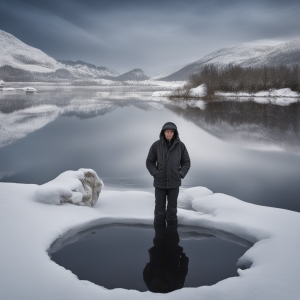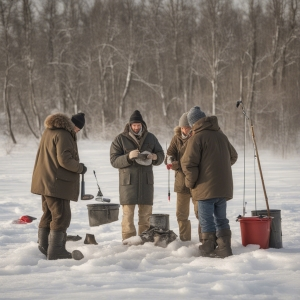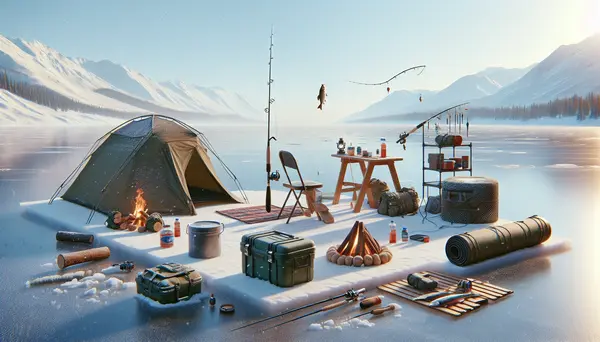Table of Contents:
For many, the thought of plunging temperatures and icy landscapes signals the end of the fishing season. But for a hardy few, the cold heralds the exciting start of a new adventure - ice fishing. If you've ever wanted to try your hand at this unique form of fishing, you're at the right place. This article will provide a comprehensive beginner-friendly guide on ice fishing, detailing essential gear, effective techniques, and imperative safety tips. By the end, you'll be well-equipped to start your chilly angling journey.
The Essential Gear: Kit Out For Your Ice Fishing Adventure
Before stepping onto the ice, it's crucial to equip yourself with the right gear. Ice fishing requires a more specialized set of equipment compared to regular fishing. Imagine yourself braving the chilled winds to reel in that big catch. To do this correctly and comfortably, the first item on your list should be an ice fishing rod and reel. These rods are shorter and lighter, perfect for the delicate work of luring fish under the ice.
Next, consider getting an ice auger. An auger is a tool used for cutting through the ice, providing you a hole to fish through. They come in manual, electric, or gas-powered models, depending on your preference. Choose one that's easy to handle yet strong enough to pierce the ice, as the ice's thickness can vary.
Another essential piece is a slush scoop. It is used to clear the ice shards and slush from your fishing hole. Keeping your hole clear is vital for visibility and preventing it from freezing over swiftly.
Lastly, always remember that ice fishing can be a chilly business. Wiggle your fingers in some insulated gloves, and don a thermal suit to keep you warm and cozy while awaiting the tug of the fish. Theres nothing quite as frustrating as catching a cold when you're out catching fish!
Testing the Ice: Prioritize Safety First
Once you're well-equipped, safety should be your next concern. The key to a successful ice fishing trip is ensuring the ice is safe to stand and fish on. The minimum thickness for safe ice fishing is roughly 4 inches of clear, solid ice. Anything less and you're playing a risky game with your safety.
So, how do you check the ice thickness before venturing onto it? One tool to consider is an ice chisel or spud bar. It helps give a rough estimate of the ice thickness. Simply drive the chisel into the ice and measure how much penetrates.
Another approach is to use an auger to bore a pilot hole and then measure the thickness with a tape measure or ice skimmer. You can also look for signs of weak ice like cracks, flowing water, or dark patches.
Remember that ice can differ in thickness over a short distance, especially at the start of the winter season. Always keep an eye out and avoid areas around structures such as docks, logs, and vegetation which can weaken ice.
The Essentials of Ice Fishing for Beginners
| Pros | Cons |
|---|---|
| Rich in adventure | Exposure to extreme cold weather conditions |
| Potential to catch a variety of fish species | Requires special gear |
| An exciting way to engage with nature in winter | Requires safety knowledge and caution (e.g., understanding ice thickness) |
| Opportunity to learn new techniques and fishing skills | May need to invest in ice fishing specific equipment |
| Economic impact on local communities | Could be harmful to fish populations if not done responsibly |
Techniques to Master: Know Your Craft

When it comes to ice fishing, it's not all about the gear. You need to grasp certain techniques to become a successful ice angler. First, you must get acquainted with the concept of jigging. It's a method of moving your bait in a vertical, up-and-down motion to attract fish. Subtly wiggling your rod tip can make your bait look tempting!
Next, learn vising a fish finder or depth finder. These nifty devices can help you locate schools of fish under the ice, saving you precious time and effort. They can also help in figuring out the lake's depth which can be advantageous when looking for certain types of fish.
Another important technique is knowing how to set your bait. The choice of bait can vary depending on the fish species. Usual selections include small minnows, waxworms, or plastic baits. Knowing what the fish in your area prefer can be a game-changer.
Lastly, remember that patience plays a crucial part in fishing. Unlike open water fishing, fish under the ice are more lethargic and may take longer to bite. Don't be disheartened if you are not catching fish right away. Perseverance is key!
Identifying the Right Spot: Seek and You Shall Find
Finding the right spot to drill your hole is an essential aspect of ice fishing. It needs a bit of luck, a touch of skill, and in-depth knowledge of the waters you are fishing. Here are some points to consider.
First, consider fishing near structures. Fish tend to congregate near underwater features like underwater trees, rock formations, and dips or valleys in the lake bed. If you know of such spots from summer fishing or have a lake map, those can be excellent places to start.
Another tip is to spot areas where other anglers are fishing. Ice fishing is a unique sport where you don't necessarily need to stray far away for a good catch. If you see a group of huts or a cluster of holes, that could indicate a hotspot.
Last but not least, pay attention to the waters depth. Certain fish species prefer certain water depths. For instance, trout and salmon are often found at greater depths, while perch, pike, and bass could be closer to the surface. Of course, this varies greatly depending on the time of the day and the particular lake.
So, ready your auger and drill some holes. Dont be scared to move around if youre not getting bites. As they say, if the fish aren't biting, keep on moving.
Ice Fishing Etiquette: Be Responsible, Be Respectful

Not only is ice fishing a test of skill and patience, it's also a social activity. As such, observing proper etiquette not only boosts the enjoyment of the experience, but also ensures safety and respect for all participants. A few key pointers include keeping a polite distance from other anglers' holes unless invited closer. It's also essential to clean up after yourself and to avoid making excessive noise, both to maintain a pleasant ambiance and not to scare away the fish.
Remember, we share these spaces with wildlife as well, so be conscientious about your impact on the environment. For instance, discarded fishing line can be detrimental to birds and other wildlife. Taking these small steps can make a world of difference in your ice fishing journey and set an example for other newbie anglers. The golden rule of thumb: leave the ice as you found it.
Conclusion: Take the Plunge into Ice Fishing
So there you have it - a basic overview of ice fishing. Even though it might initially seem a bit intimidating, once you get the hang of it, ice fishing can be an incredibly rewarding and enjoyable way to spend those winter months. The freezing temperatures might test your resilience, but the thrill of reeling in a frigid catch is unmatched.
With the right gear, a keen understanding of effective techniques, and a steadfast commitment to safety, you'll find yourself seamlessly transitioning from a beginner to a seasoned ice angler. Remember, every master was once a beginner. Now it's your time to step onto the ice and embark on this unique fishing journey.
Ice fishing offers an entirely different perspective on the sport. It blends the quiet solitude of a winter landscape with the anticipation of the next big catch right beneath your feet. It's more than fishing; it's an adventure that gives you a story to tell. So, are you ready to take the plunge and turn ice into your newest fishing ground?
Beginner's Guide to Ice Fishing: Gear, Techniques, and Safety

What equipment is needed for beginners in ice fishing?
Beginners in ice fishing need basic items such as an ice auger, insulated boots, fishing rod, good-quality bait, and a sled for transporting. More advanced gear can include underwater cameras and GPS units.
What are some ice fishing techniques for beginners?
Basic techniques for beginners include choosing the right location and understanding ice safety. Drill multiple holes in the ice to find where fish are biting. Use live bait and jigging techniques for better results.
What safety precautions should I take when ice fishing?
Ice fishing safety guidelines recommend never fishing alone, always checking the ice thickness, carrying ice picks and rope, and wearing a life preserver beneath your clothing.
How to choose the right bait for ice fishing?
The choice of bait depends on the type of fish you are targeting. Minnows, wax worms, and artificial lures can be effective. Use smaller baits and hooks for better results.
What clothing should I wear for ice fishing?
Wear clothing that will keep you warm and dry. Wear multiple layers, including a base layer that wicks away moisture, a middle layer that retains heat, and an outer layer that is waterproof and windproof. Insulated boots and gloves are also a must.







